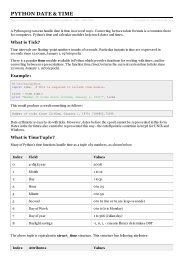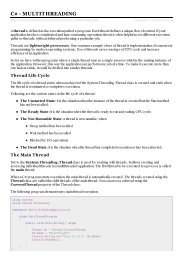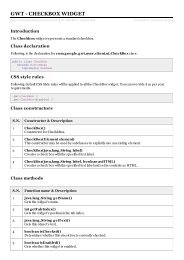download pascal tutorial (pdf - Tutorials Point
download pascal tutorial (pdf - Tutorials Point
download pascal tutorial (pdf - Tutorials Point
You also want an ePaper? Increase the reach of your titles
YUMPU automatically turns print PDFs into web optimized ePapers that Google loves.
For-do LOOP<br />
A for-do loop is a repetition control structure that allows you to efficiently write a loop<br />
that needs to execute a specific number of times.<br />
Syntax:<br />
The syntax for the for-do loop in Pascal is as follows:<br />
for < variable-name > := < initial_value > to [down to] < final_value > do<br />
S;<br />
Where, the variable-name specifies a variable of ordinal type, called control variable or<br />
index variable; initial_value and final_value values are values that the control variable can<br />
take; and S is the body of the for-do loop that could be a simple statement or a group of<br />
statements.<br />
For example:<br />
for i:= 1 to 10 do writeln(i);<br />
Here is the flow of control in a for-do loop:<br />
<br />
<br />
<br />
<br />
The initial step is executed first, and only once. This step allows you to declare<br />
and initialize any loop control variables.<br />
Next, the condition is evaluated. If it is true, the body of the loop is executed. If it<br />
is false, the body of the loop does not execute and flow of control jumps to the<br />
next statement just after the for-do loop.<br />
After the body of the for-do loop executes, the value of the variable in increased<br />
or decreased.<br />
The condition is now evaluated again. If it is true, the loop executes and the<br />
process repeats itself (body of loop, then increment step, and then again<br />
condition). After the condition becomes false, the for-do loop terminates.<br />
TUTORIALS POINT<br />
Simply Easy Learning Page 46
















